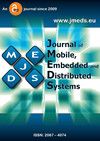Security System for Mobile Voting with Biometrics
Keywords:
Mobile Voting, Android, Biometrics, Face detection, Face Recognition, SSL, Encryption, Local Binary Patterns, OpenCVAbstract
For centuries, voting has been a democratic right and way to choose our politicians. Nowadays, the voting process became a major issue in order to avoid crucial vulnerabilities like multiple voting, missing ballot papers, electoral fraud and miscount votes in an election.
To prevent those leaks in our current voting system and to improve other factors like time-consuming and reducing cost of resources, I decided to implement a secured mobile voting system on android.
In today’s era, the number of people that possess a smart-phone is larger and larger and also the advanced stage of technology can concur to a reliable solution for voting.
The architecture of this system will contain the mobile application that need to be installed on a mobile device, also will contain a server to compute multiple operations (face detection, face recognition and matching the face with the existing ones, matching unique id of the smart-phone with the one stored in database based on user personal identification number) and a server database. Firstly, an introduction about the subject and system is presented. Problem formulation will contain a research about this topic. Solution of the problem is presented in four subsections: architecture of the system, implementation, face recognition verifier and other solutions.
References
Ofori-Dwumfuo, G. O., & Paatey, E. 2011. The design of an electronic voting system. Research Journal of Information Technology 3 (2) , 91-98.
Gentles, D., & Sankaranarayanan, S. 2012. Application of biometrics in mobile voting. I. J. Computer Network and Information Security, 57-68.
“Electronic Voting,” Encyclopedia of Computers and Computer History, prepared by Lorrie Faith Cranor and edited by Raul Rojas, published by Fitzroy Dearborn, 2001.
“Voting – What is, What Could be,” Caltech/MIT Voting Technology Project (VTP) Report, July 2001.
“Electronic Voting,” Ronald L. Rivest, Technical Report, Laboratory for Computer Science, Massachusetts Institute of Technology.
“Secure Voting Using Disconnected, Distributed Polling Devices,” David Clausen, Daryl Puryear and Adrian Rodriguez, Department of Computer Science, Stanford University.
Zhao, W., Chellappa, R., Rosenfeld, A., Phillips, P. J.: Face recognition: a literature survey. Technical Report CAR-TR-948, Center for Automation Research, University of Maryland (2002).
Electronic Voting (2009), Available from http://www.hwskioskprinter.com/terminology electronic voting.pdf.
OpenCV project, http://opencv.org
Downloads
Published
How to Cite
Issue
Section
License
Authors who publish with this journal agree to the following terms:
- Authors retain copyright and grant the journal right of first publication with the work simultaneously licensed under a Creative Commons Attribution License that allows others to share the work with an acknowledgement of the work's authorship and initial publication in this journal.
- Authors are able to enter into separate, additional contractual arrangements for the non-exclusive distribution of the journal's published version of the work (e.g., post it to an institutional repository or publish it in a book), with an acknowledgement of its initial publication in this journal.
- Authors are permitted and encouraged to post their work online (e.g., in institutional repositories or on their website) prior to and during the submission process, as it can lead to productive exchanges, as well as earlier and greater citation of published work (See The Effect of Open Access).
- The author(s) is responsible for the correctness and legality of the paper content.
- Papers that are copyrighted or published will not be taken into consideration for publication in JMEDS It is the author(s) responsibility to ensure that the paper does not cause any copyright infringements and other problems.
- It is the responsibility of the author(s) to obtain all necessary copyright release permissions for the use of any copyrighted materials in the paper prior to the submission.
- The Author(s) retains the right to reuse any portion of the paper, in future works, including books, lectures and presentations in all media, with the condition that the publication by JMEDS is properly credited and referenced.

JMEDS articles by Journal of Mobile, Embedded and Distributed Systems (JMEDS) is licensed under a Creative Commons Attribution 4.0 International License.
Based on a work at http://jmeds.eu.
Permissions beyond the scope of this license may be available at http://jmeds.eu/index.php/jmeds/about/submissions#copyrightNotice.




